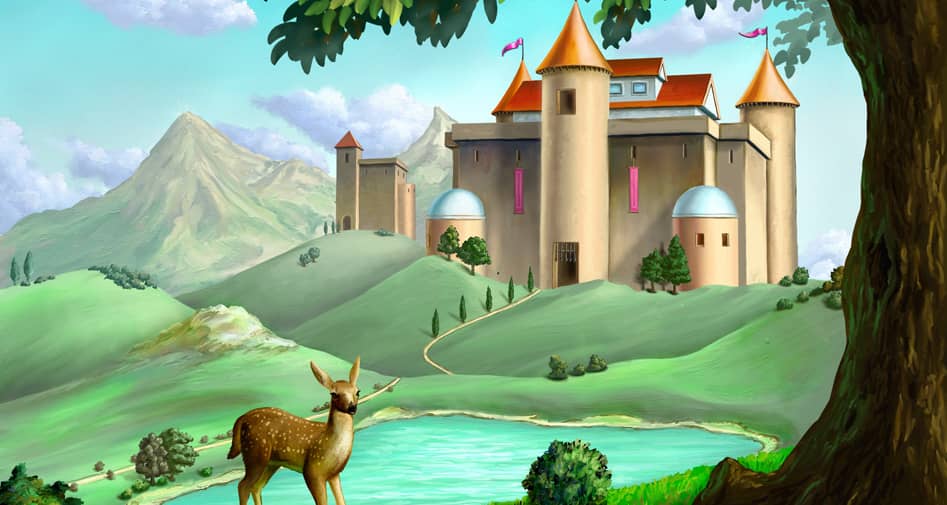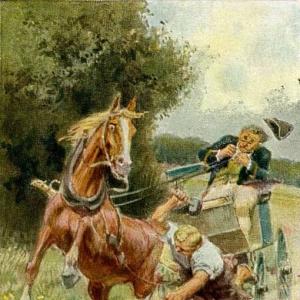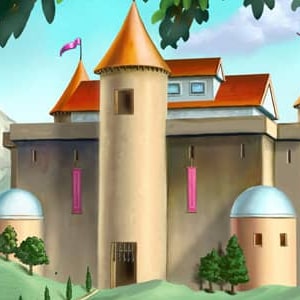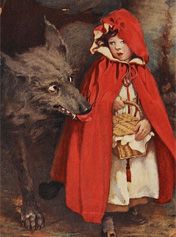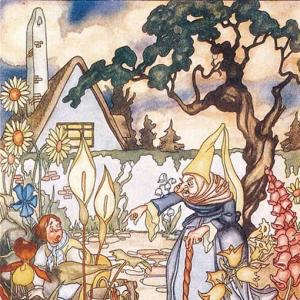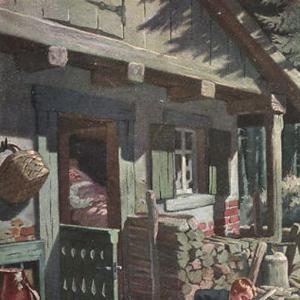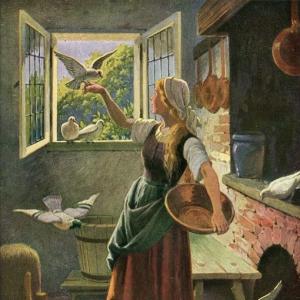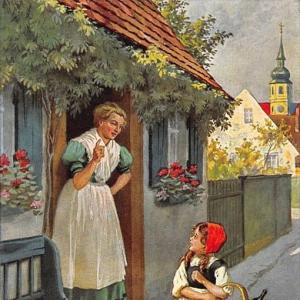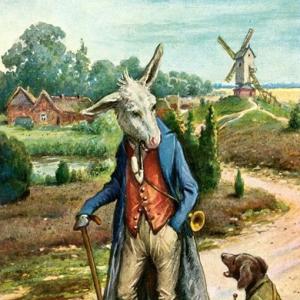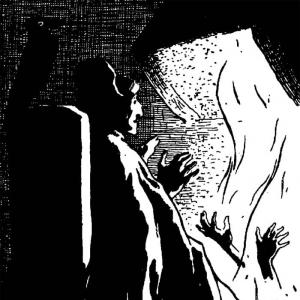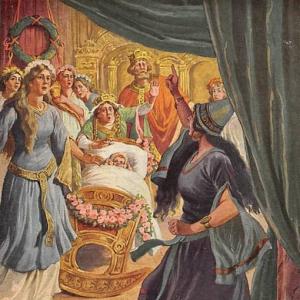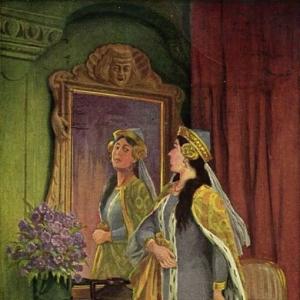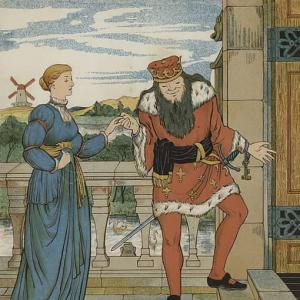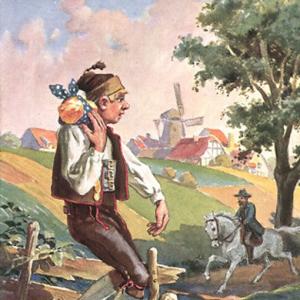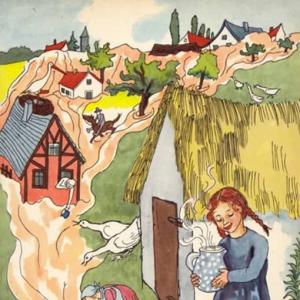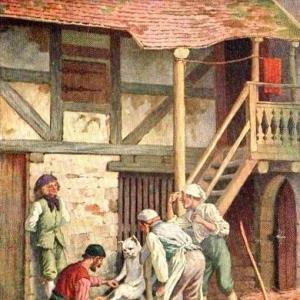Reading time for children: 10 min
There was once a young man who was studying to be a poet. He wanted to become one by Easter, and to marry, and to live by poetry. To write poems, he knew, only consists in being able to invent something; but he could not invent anything. He had been born too late– everything had been taken up before he came into the world, and everything had been written and told about.
„Happy people who were born a thousand years ago!“ said he. „It was an easy matter for them to become immortal. Happy even was he who was born a hundred years ago, for then there was still something about which a poem could be written. Now the world is written out, and what can I write poetry about?“ Then he studied till he became ill and wretched, the wretched man! No doctor could help him, but perhaps the wise woman could.
She lived in the little house by the wayside, where the gate is that she opened for those who rode and drove. But she could do more than unlock the gate. She was wiser than the doctor who drives in his own carriage and pays tax for his rank. „I must go to her,“ said the young man. The house in which she dwelt was small and neat, but dreary to behold, for there were no flowers near it – no trees. By the door stood a bee-hive, which was very useful.
There was also a little potato-field, very useful, and an earth bank, with sloe bushes upon it, which had done blossoming, and now bore fruit, sloes, that draw one’s mouth together if one tastes them before the frost has touched them. „That’s a true picture of our poetryless time, that I see before me now,“ thought the young man; and that was at least a thought, a grain of gold that he found by the door of the wise woman.
„Write that down!“ said she. „Even crumbs are bread. I know why you come hither. You cannot invent anything, and yet you want to be a poet by Easter.“ – „Everything has been written down,“ said he. „Our time is not the old time.“ – „No,“ said the woman. „In the old time wise women were burnt, and poets went about with empty stomachs, and very much out at elbows. The present time is good, it is the best of times; but you have not the right way of looking at it.
Your ear is not sharpened to hear, and I fancy you do not say the Lord’s Prayer in the evening. There is plenty here to write poems about, and to tell of, for any one who knows the way. You can read it in the fruits of the earth, you can draw it from the flowing and the standing water; but you must understand how– you must understand how to catch a sunbeam. Now just you try my spectacles on, and put my ear-trumpet to your ear, and then pray to God, and leave off thinking of yourself.“
The last was a very difficult thing to do – more than a wise woman ought to ask. He received the spectacles and the ear-trumpet, and was posted in the middle of the potato-field. She put a great potato into his hand. Sounds came from within it. There came a song with words, the history of the potato, an every-day story in ten parts, an interesting story. And ten lines were enough to tell it in. And what did the potato sing?
She sang of herself and of her family, of the arrival of the potato in Europe, of the misrepresentation to which she had been exposed before she was acknowledged, as she is now, to be a greater treasure than a lump of gold. „We were distributed, by the King’s command, from the council-houses through the various towns, and proclamation was made of our great value. But no one believed in it, or even understood how to plant us.
One man dug a hole in the earth and threw in his whole bushel of potatoes. Another put one potato here and another there in the ground, and expected that each was to come up a perfect tree, from which he might shake down potatoes. And they certainly grew, and produced flowers and green watery fruit, but it all withered away. Nobody thought of what was in the ground– the blessing– the potato. Yes, we have endured and suffered, that is to say, our forefathers have. They and we, it is all one. „What a story it was!
„Well, and that will do,“ said the woman. „Now look at the sloe bush.“ – „We have also some near relations in the home of the potatoes, but higher towards the north than they grew,“ said the Sloes. „There were Northmen, from Norway, who steered westward through mist and storm to an unknown land, where, behind ice and snow, they found plants and green meadows, and bushes with blue-black grapes– sloe bushes. The grapes were ripened by the frost just as we are. And they called the land Wine-land, that is, Groenland or Sloeland.“
„That is quite a romantic story,“ said the young man. „Yes, certainly. But now come with me,“ said the wise woman, and she led him to the bee-hive. He looked into it. What life and labor! There were bees standing in all the passages, waving their wings, so that a wholesome draught of air might blow through the great manufactory. That was their business. Then there came in bees from without, who had been born with little baskets on their feet.
They brought flower-dust, which was poured out, sorted, and manufactured into honey and wax. They flew in and out. The queen-bee wanted to fly out, but then all the other bees must have gone with her. It was not yet the time for that, but still she wanted to fly out. So the others bit off her majesty’s wings, and she had to stay where she was. „Now get upon the earth bank,“ said the wise woman. „Come and look out over the highway, where you can see the people.“
„What a crowd it is!“ said the young man. „One story after another. It whirls and whirls! It’s quite a confusion before my eyes. I shall go out at the back.“ – „No, go straight forward,“ said the woman. „Go straight into the crowd of people, look at them in the right way. Have an ear to hear and the right heart to feel, and you will soon invent something. But, before you go away, you must give me my spectacles and my ear-trumpet again.“ And so saying, she took both from him.
„Now I do not see the smallest thing,“ said the young man, „and now I don’t hear anything more.“ – „Why, then, you can’t be a poet by Easter,“ said the wise woman. „But, by what time can I be one?“ asked he. „Neither by Easter nor by Whitsuntide! You will not learn how to invent anything.“ – „What must I do to earn my bread by poetry?“
„You can do that before Shrove Tuesday. Hunt the poets! Kill their writings and thus you will kill them. Don’t be put out of countenance. Strike at them boldly, and you’ll have carnival cake, on which you can support yourself and your wife too.“ – „What one can invent!“ cried the young man. And so he hit out boldly at every second poet, because he could not be a poet himself. We have it from the wise woman. She knows What One Can Invent.
 Learn languages. Double-Tap on one word.Learn languages in context with Childstories.org and Deepl.com.
Learn languages. Double-Tap on one word.Learn languages in context with Childstories.org and Deepl.com.Backgrounds to fairy tale „What One Can Invent“
„What One Can Invent“ is a fairy tale written by the famous Danish author Hans Christian Andersen, who was born on April 2, 1805, and passed away on August 4, 1875. Andersen is best known for his literary fairy tales, which have been translated into numerous languages and have become an essential part of children’s literature worldwide. Some of his most famous works include „The Little Mermaid,“ „The Ugly Duckling,“ „The Emperor’s New Clothes,“ and „The Snow Queen.“
Andersen’s fairy tales often contain moral lessons and address universal themes, such as love, loss, and transformation. Many of his stories are known for their vivid imagination, rich symbolism, and emotional depth. His tales were initially intended for both children and adults, and they continue to be enjoyed by readers of all ages today.
„What One Can Invent“ is a lesser-known tale by Andersen that offers valuable lessons about perspective, inspiration, and the importance of hard work and persistence in achieving one’s goals. The story also explores themes such as envy, bitterness, and the power of nature and ordinary things in inspiring creativity.
It is essential to note that Andersen’s fairy tales were written in the 19th century, a time when societal norms, values, and expectations were different from those in the present day. Some aspects of the story, such as the young man’s decision to attack other poets and their works, may not align with contemporary values, but they can still offer insights into human nature and the challenges faced by creative individuals throughout history.
„What One Can Invent“ is a lesser-known fairy tale by Hans Christian Andersen, first published in 1858. The story explores the power of imagination, creativity, and the importance of not taking things for granted. The moral of the story is to appreciate the beauty and potential in ordinary things and not to take them for granted. The tale encourages its readers to look beyond the surface and find inspiration in the world around them. As a fairy tale, „What One Can Invent“ highlights the importance of creativity, imagination, and the power of the human mind to transform the ordinary into the extraordinary.
Interpretations to fairy tale „What One Can Invent“
There are several interpretations that can be drawn from Hans Christian Andersen’s fairy tale, „What One Can Invent“:
The Importance of Perspective: The story highlights the significance of having the right perspective in life. The young man initially believes that everything has been written and told, but the wise woman shows him that there is still much to discover and write about. By changing his viewpoint and learning to appreciate the ordinary things around him, the young man realizes that there is still potential for creativity and innovation.
Inspiration in Everyday Life: The tale teaches that inspiration can be found in the simplest and most mundane aspects of life. The potato, sloe bush, and bees all have their unique stories, reminding readers that even the most ordinary things can be a source of inspiration if observed and appreciated with the right mindset.
The Dangers of Envy and Bitterness: The young man’s inability to become a poet by Easter leads him to attack other poets and their works, as advised by the wise woman. This can be seen as a cautionary tale about the negative consequences of envy and bitterness. Instead of focusing on his growth and learning from others, the young man chooses to bring others down to make a living, which may not be a fulfilling or morally right path.
The Role of Hard Work and Persistence: The story also underscores the importance of hard work and persistence in achieving one’s goals. The young man wants to become a poet by Easter but does not put in the necessary effort to truly understand and appreciate the world around him. It suggests that success and creativity cannot be achieved overnight, but through continuous learning, exploration, and perseverance.
The Power of Nature and the Ordinary: The tale serves as a reminder of the inherent beauty and wisdom in nature and the ordinary things around us. By listening to the stories of the potato, sloe bush, and bees, the young man learns valuable lessons that he could not find in books or through conventional learning. This underscores the idea that wisdom can be found in unexpected places, and that nature and the ordinary can offer profound insights and inspiration.
Overall, „What One Can Invent“ is a celebration of creativity, imagination, and the human spirit, encouraging readers to find beauty and inspiration in the world around them and to push beyond the limitations set by society.
Adaptions of the fairy tale „What One Can Invent“
Hans Christian Andersen’s fairy tale „What One Can Invent“ has been adapted and reinterpreted in various forms over the years. Here are a few notable adaptations:
Children’s book: „I Can Invent Anything!“ (2022): In this adaptation, a young girl named Emily finds a magical pencil that allows her to draw any invention she can imagine, and it comes to life. The book follows Emily as she learns the responsibility that comes with her newfound power and how to use it for the greater good.
Animation or Films: „Inventor’s Dream“ (2019): This animated film is loosely based on „What One Can Invent“ and tells the story of a young inventor named Tom who discovers a magical blueprint that brings his ideas to life. Tom uses this newfound power to create fantastical inventions, but he must learn to control his creativity when it starts to have unintended consequences.
Stage play: „Inventive Minds“ (2017): A theatrical adaptation of Andersen’s tales, this stage play tells the story of a brother and sister who discover a magical invention lab hidden in their attic. The play combines elements of comedy, drama, and fantasy as the siblings learn valuable lessons about creativity, responsibility, and the importance of teamwork.
Art exhibition: „The Power of Imagination: Inspired by Hans Christian Andersen“ (2018): This art exhibition showcases the works of various artists who were inspired by Andersen’s „What One Can Invent“ and other tales. Visitors can explore sculptures, paintings, and installations that reinterpret the themes of creativity, imagination, and invention present in the original story.
Educational material: The story was adapted into educational resources, such as lesson plans or classroom activities, to help teach children about creativity, imagination, and the importance of thinking outside the box.
Overall, „What One Can Invent“ has been adapted in various forms over the years, each highlighting different aspects of the story’s themes of innovation, skepticism, and perseverance.
Summary of the plot
„What One Can Invent“ is a fairy tale by Hans Christian Andersen that tells the story of a young man who aspires to be a poet by Easter, marry, and live by his poetry. However, he struggles to invent anything new as he feels everything has been written and told before. Desperate, he seeks the help of a wise woman who lives in a small house by the roadside.
The wise woman’s house is surrounded by useful things like a bee-hive, a potato field, and an earth bank with sloe bushes. The young man begins to realize that there is still much to learn and write about. The wise woman lends him her spectacles and ear-trumpet and asks him to listen to the stories of the potato, the sloe bush, and the bees.
The potato sings about its history and the struggles it faced before being recognized as a valuable resource. The sloe bush tells a romantic tale of Northmen discovering Greenland, where they found sloe bushes with blue-black grapes. The young man then observes the bustling bee-hive and learns about the labor and life within it.
The wise woman then leads the young man to an earth bank overlooking a highway filled with people. She advises him to immerse himself in the crowd and observe them with the right perspective, as well as an open ear and heart. Before he leaves, she takes back her spectacles and ear-trumpet, leaving the young man feeling lost.
Realizing that he cannot become a poet by Easter, the young man asks when he will be able to do so. The wise woman tells him that he will never learn how to invent anything, but he can still earn a living by attacking other poets and their works. Following her advice, the young man critiques every second poet, earning enough to support himself and his wife. The story, as told by the wise woman, serves as a reminder of the importance of perspective and the endless possibilities for invention and creativity in the world around us.
Informations for scientific analysis
Fairy tale statistics | Value |
|---|---|
| Translations | EN, DA, ES, NL |
| Readability Index by Björnsson | 22.9 |
| Flesch-Reading-Ease Index | 86.8 |
| Flesch–Kincaid Grade-Level | 4.4 |
| Gunning Fog Index | 7.3 |
| Coleman–Liau Index | 7.7 |
| SMOG Index | 8 |
| Automated Readability Index | 3.8 |
| Character Count | 6.766 |
| Letter Count | 5.130 |
| Sentence Count | 99 |
| Word Count | 1.287 |
| Average Words per Sentence | 13,00 |
| Words with more than 6 letters | 128 |
| Percentage of long words | 9.9% |
| Number of Syllables | 1.626 |
| Average Syllables per Word | 1,26 |
| Words with three Syllables | 68 |
| Percentage Words with three Syllables | 5.3% |
